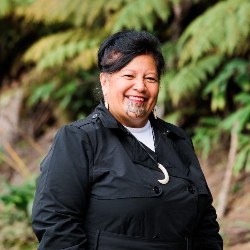Opotiki stopbanks pass the 30-year flood test
MEDIA RELEASE

CAPTION: As expected, the floodwater overtopped rural stopbanks with lower flood protection levels.
Opotiki stopbanks pass the 30-year flood test
For immediate release: Monday 6 October 2003
Opotiki’s stopbanks, which help to protect the vulnerable township from flooding, passed a major test with flying colours over the weekend.
While residents slept on Friday night, the nearby Otara River raged in full flood. At one time, the river had risen by four metres in places and was channelling nearly as much water as it did during a major event in1965.
Environment Bay of Plenty’s group manager operational services, Clive Tozer, says the town’s newly strengthened stopbanks “did a great job” in keeping the town safe.
Over the last two years, Environment Bay of Plenty has upgraded Opotiki’s urban system to provide a higher level of flood protection. In some places, stopbanks have been lifted by as much as a metre.
“Without the recent work, they would still have coped - but only just,” Mr Tozer says. “The upgrade has given the people of Opotiki a greater degree of comfort at times like this.”
The flood was a difficult test and “we are really very pleased with how it worked out. The stopbanks performed to the required standard, the warnings all got out in good time, and the field staff did well with their monitoring and in assisting landowners.”
Opotiki township sits at the junction of the Waioeka and Otara Rivers within a 41sq km area of floodplain. Major floods used to regularly devastate the area, with four major events recorded over the last 100 years, including a 1964 flood that covered most of the floodplain and filled nearly all of Opotiki’s 650 homes with muddy water. Another flood in 1965, kicked off by similar rainfall to last weekend’s event, flooded parts of the residential area.
Since then, the network of stopbanks has offered “a greater degree of security” to the floodplain, Mr Tozer says. However the town will always be vulnerable, particularly when both rivers are in flood. “Luckily that was not the case this time. “
More than 170mm of rain fell on already soaked ground in the upper part of the catchment over 12 hours on Friday night. At its peak, early on Saturday morning, the Otara River clocked a flow of 730 cubic metres a second. It was a 30-year flood event, says Peter Blackwood, the council’s manager technical services.
While the urban stopbanks have been upgraded to cope with 100-year flood levels, the district’s extensive network of rural stopbanks provides different degrees of flood protection. Last weekend, floodwater overtopped several rural stopbanks with five-year flood protection and one with 20-year. Several farms flooded and roads were blocked by water.
Mr Blackwood says good grass cover on the rural stopbanks meant they did not get damaged by the overtopping.
Environment Bay of Plenty already plans to upgrade parts of the rural system this financial year and the flood will provide important corroborative information for this work, Mr Blackwood says. “We’re not trying to block off all escape routes for the water. While we want to protect certain pieces of land, we must still let water escape somewhere. We must release the pressure before it gets to the coast – and the town.”
ENDS


 Gordon Campbell: On bird flu, AUKUS entry fees and Cindy Lee
Gordon Campbell: On bird flu, AUKUS entry fees and Cindy Lee NZ Government: New Lab To Help Protect Key Pacific Tuna Fisheries
NZ Government: New Lab To Help Protect Key Pacific Tuna Fisheries Susan Botting - Local Democracy Reporter: Ruawai Leader Slams Kaipara Council In Battle Over $400k Property
Susan Botting - Local Democracy Reporter: Ruawai Leader Slams Kaipara Council In Battle Over $400k Property Te Pati Maori: Another ‘Stolen Generation’ Enabled By Court Ruling On Waitangi Tribunal Summons
Te Pati Maori: Another ‘Stolen Generation’ Enabled By Court Ruling On Waitangi Tribunal Summons Peace Action Wellington: Die In for Palestine Marks ANZAC day
Peace Action Wellington: Die In for Palestine Marks ANZAC day Labour Party: Penny Drops – But What About Seymour And Peters?
Labour Party: Penny Drops – But What About Seymour And Peters? Government: PM Announces Changes To Portfolios
Government: PM Announces Changes To Portfolios


